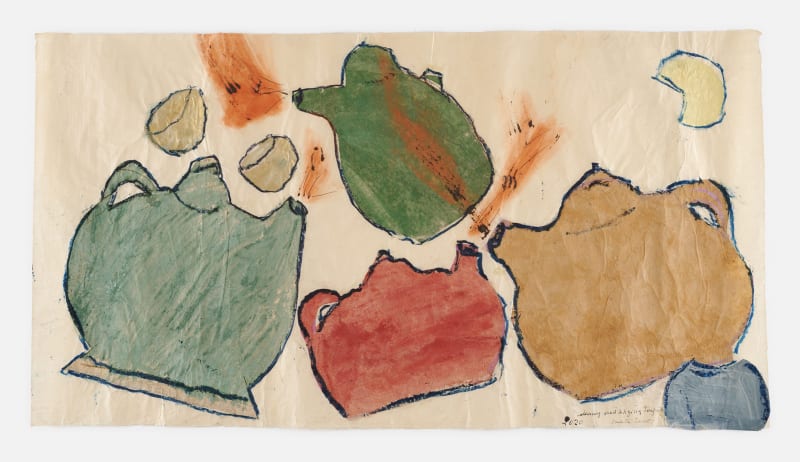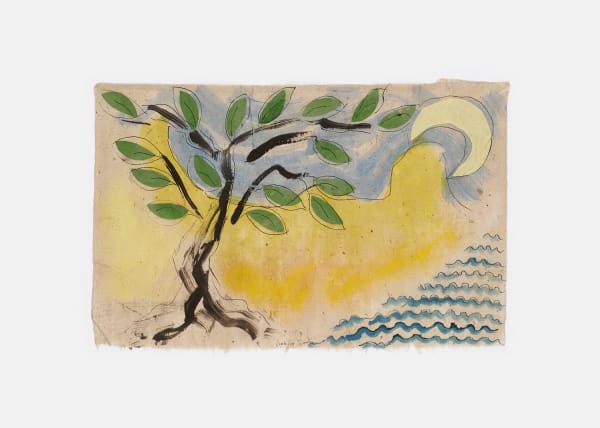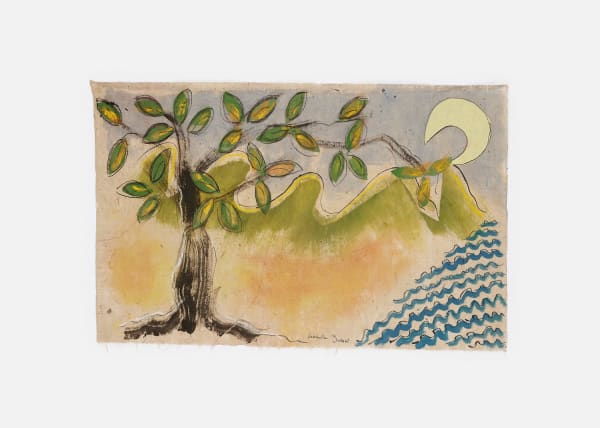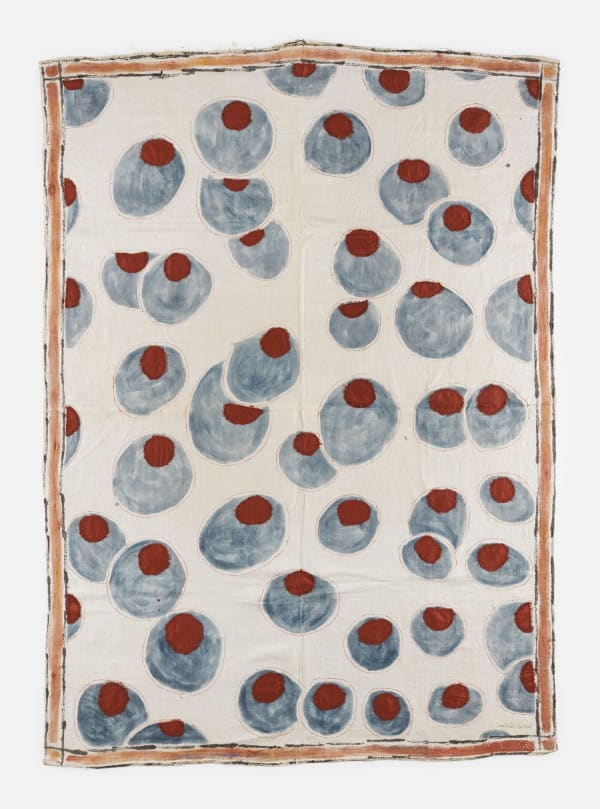Nothing is bigger: Isabella Ducrot
Cosmic Tapestry
Isabella Ducrot
By Joanna Persman
The small things … nothing is bigger.
Imagine space as a continuously expanding, huge fabric. Billions of invisible threads connecting planets, stars and galaxies. Crossroads forming. Gaps are as important as anything else. The past is the finished part of the infinite tapestry of the universe. The future is a warp, ready to receive all the seemingly random events, bold adventures and carefully calculated plans. A warp that will be transformed into a complex weave, as if all our destinies rested in the large hands of the universe.
In her texts and books, the Italian artist Isabella Ducrot, expresses similar thoughts. Her art has grown successively from a deep fascination of old fabrics, cloth and weaves, and their underlying patterns, a founding structure that either binds everything together or makes it fall apart.
Isabella Ducrot was born in Naples in 1931. Her childhood area, Montedidio, situated high up on the mountains with a view overlooking Naples and the Guld of Naples, is a spectacular place between the hills, the seaside landscape and the enigmatic silhouette of Mount Vesuvius. Numerous mysteries meet here. Profane, spiritual and cultural. The interaction between earth, fire, air and water feels stronger here than anywhere else.
According to Ducrot herself, she was sensitive to aesthetic impressions from an early age. One of her great insights came during a visit to the Uffizi Gallery in Florence, standing in front of the gothic triptych Annunciation by the artist Simone Martini (approx. 1284-1344).
She describes the magnetic powers of the work as the experience of an earthquake.
However, Ducrot is more interested in the profane than the religious mystery. She is attracted to the things that are right in front of us but still remain invisible due to their seemingly minor meaning in the universe. The overlooked objects that we use daily have a fascinating importance, both practically and symbolically. They are also surrounded by a peculiar aura when studied up close. In the greyness of the ordinary many mysteries are hidden, as well as the secrets of our own hearts. Fabrics can be found among our mundane companions. For many years, Ducrot travelled and stayed for longer periods in the east, in China, Tibet and Afghanistan, among other countries. The fabrics she then collected have both inspired and become parts of her own artworks.
In his study, Looking at the Overlooked. Four Essays on Still Life Painting (1990), Norman Bryson points to how the plainest forms in our daily life, the shapes of vases, pots and fabric patterns are indestructible. Their design change with the passing of time and according to new trends, but the basic forms of a chalk, a vessel or an oil lamp are strong enough to be passed on, generation to generation through millenniums and centuries. This is also true for the basic shape of a fabric. Bryson writes about how complicated tools are exposed to quick transformations, simple utensils instead follow a slow, almost geological rhythm. It is as if simple things are created in an intergenerational consensus. These forms are perceived as being right for their purpose. They belong to aevum - an era with a beginning but no end. This is why these things are larger than each unique individual and larger than whole generations.
Weaves, fabrics and tapestries can appear as if they are transgressing boundaries. They are often utility items, placed within the context of genuine craft. Objects made to protect the body, or to be used in the household. Patches, handkerchiefs and sheets. Everyday objects that often touch our bodies and witness our most intimate moments. The fabric is the first object a new born child comes in contact with upon leaving the body of the mother. A shroud is the last object that follows us into the grave. The secret of the weave is that it is at the same time a practical object and a work of art in itself. A work of art that with its combination of crossed threads and empty space is a charged metaphor for the circle of life.
Isabella Ducrot's experiments with different techniques are about finding expressive forms, and at the same time keeping the respect for the origins of the material. Her fabrics, sometimes unassuming, sometimes valuable, can serve as something else than the original function. They become materials in new works of art. Dyed, cut apart and re-assembled, they tell new stories. Fabric, even luxurious, is often seen as an unpretentious material, tied to the feminine realm. Ducrot discusses this more in-depth in her books. As a visual artist, she connects to this question by creating small maps, "mappine" She deconstructs and reconstructs small pieces of fabric used for centuries in monasteries. The nuns re-used pieces of fabric by ripping up the seams and sewing them together using microscopical stitches. Ducrot exposes their ancient artistic skills. Her textile works, with sophisticated simple repeated patterns leads the thoughts both forward and backward in time. Here seeds to abstract art and concrete shapes are hidden, long before concepts of them existed.
True art, Herman Hesse suggested in his educational novel Narziss und Goldmund written in 1930, is born in where ideas and practice meet. Only someone who controls technique and the physical - the material world if you like- can create something and make it come to life. The idea must be shaped by the practice, and not only be a part of the spiritual world. Hesse reminded us that the artist must be both a thinker and craftsman united in one.
In the art of Isabella Ducrot the concrete, the everyday and the real are woven together with something ephemerally magical and universal. The result is a poetic unity, where the past and the present float together in a cosmic tapestry.
/Joanna Persman, Villa San Michele, Anacapri, September 2022
---
Isabella Ducrot was born 1931 in Naples, Italy, she lives and works in Rome, Italy.
Isabella Ducrot is known for her devoted use of woven cloth as the founding material of her artistic practice. Only beginning her artistic career later in life, the Italian artist has assembled a sublime collection of antique textiles through her extensive travels through Asia, originating primarily from Turkey, India, China, Tibet and Afghanistan.
Isabella Ducrot's recent solo shows include Art Basel Unlimited with Galerie Gisela Capitain and Standard (2022) Standard Oslo (2022) San Giuseppe alle Scalze a Pontecorvo, Napoli (2021); Galerie Gisela Capitain, Cologne (2021); Galerie Mezzanin, Geneva (2020); Capitain Petzel, Berlin (2019); and Spazio Parlato, Palermo (2018). In 2014 Ducrot had a major exhibition at the Galleria Nazionale d'Arte Moderna e Contemporanea in Rome and in 1993 and 2011 she showed her work at the Venice Biennale. Isabella Ducrot is also the author of numerous publications, including Women's Life, 2021; La stoffa a quadri (also translated and published in English as The Checkered Cloth), 2019; Suonno. Il sonno e il sogno nella canzone napoletana, 2012; Fallaste Corazón, 2012; Pensiero religioso ed elettricità, 2011; La Matassa Primordale, 2008; and Bianca di Pelle, 1995.
-
 Isabella Ducrot, Bella Terra, 2020
Isabella Ducrot, Bella Terra, 2020 -
 Isabella Ducrot, Bella Terra LII, 2020
Isabella Ducrot, Bella Terra LII, 2020 -
 Isabella Ducrot, Bella Terra LIV, 2020
Isabella Ducrot, Bella Terra LIV, 2020 -
 Isabella Ducrot, Bella Terra XLVI, 2020
Isabella Ducrot, Bella Terra XLVI, 2020












